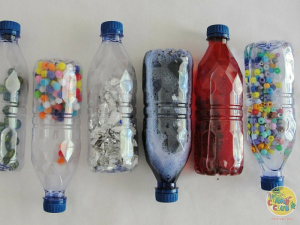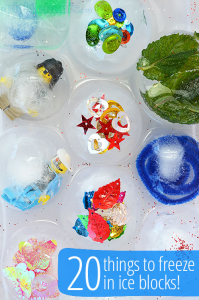Heuristic play, inspired by the concept of heuristic learning, encourages children to explore, experiment, and problem-solve through hands-on experiences.
By providing open-ended materials and opportunities for discovery, heuristic play activities can enhance a child’s sensory awareness, fine motor skills, and critical thinking abilities.
Now, we have compiled a list of easy heuristic play activities for kids.
These activities are designed to be simple, engaging, and accessible, using everyday objects and natural materials that can be found around the house or in nature.
They require minimal setup and can be adapted to suit various age groups and developmental stages.
Join us as we embark on this journey of discovery and watch as children immerse themselves in the joy of heuristic play!
Sensory Box Exploration:

Create a sensory box filled with a variety of materials for children to explore. Gather objects like smooth stones, pinecones, textured fabrics, and different textured balls. Let the children use their hands to feel the textures, compare them, and sort them according to their characteristics. Encourage them to describe what they feel and engage in conversations about their observations. This activity promotes tactile stimulation, sensory awareness, and language development as children engage their senses and describe their experiences.
Discovery Bottles:

Fill clear plastic bottles with various materials such as colorful beads, rice, water, or glitter. Seal the bottles tightly and let the children shake, roll, and observe the contents. As they manipulate the bottles, they can discover how the materials move and interact with each other. This activity enhances visual tracking, fine motor skills, and cognitive development as children explore cause and effect relationships through their observations.
Nature Scavenger Hunt:

Take children outdoors for a nature scavenger hunt. Provide them with a list of natural items to find, such as leaves, rocks, flowers, or sticks. Encourage them to collect the items in a basket or bag. As they search for and collect the items, they will engage their senses, observe nature, and develop their cognitive and fine motor skills. After the scavenger hunt, encourage children to discuss their findings and share their experiences with the natural world.
Related: 20 Fun July Activities for Preschoolers
Transferring and Sorting:

Set up a transfer and sorting activity using small containers and various objects such as buttons, beads, or pom-poms. Provide spoons, tongs, or tweezers for children to manipulate and transfer the objects from one container to another. They can sort the objects based on different attributes like color, shape, or size. This activity promotes fine motor skills, hand-eye coordination, and cognitive development as children engage in problem-solving and organization.
Sensory Painting:

Offer children a unique sensory painting experience by using unconventional painting tools and materials. Instead of brushes, provide them with sponges, cotton balls, or even natural objects like leaves or feathers. Use a variety of painting surfaces such as paper, cardboard, or fabric. Encourage children to explore different textures and experiment with mixing colors. This activity stimulates creativity, fine motor skills, and sensory exploration as children engage in a hands-on painting experience with unconventional tools and materials.
Sensory Play with Playdough:

Set up a sensory play station with different colors of playdough and a variety of tools such as cookie cutters, rolling pins, and plastic utensils. Encourage children to mold, squish, and shape the playdough using their hands and the tools provided. They can create their own imaginative designs or follow simple prompts like making animals or objects. This activity promotes fine motor skills, creativity, and sensory exploration as children engage in tactile play with the pliable dough.
Related: 20 Fun Camp Games for Small Groups
Water Play:

Fill a basin or water table with water and provide children with cups, funnels, measuring spoons, and various containers. Let them explore pouring, mixing, and transferring the water using different tools. They can experiment with sinking and floating objects or even try simple water experiments like observing the movement of colored water. Water play enhances fine motor skills, hand-eye coordination, and scientific thinking as children investigate and manipulate the properties of water.
Sensory Bin with Rice or Pasta:

Fill a shallow container with uncooked rice or pasta and hide small toys or objects within it. Provide scoops, cups, and small containers for children to dig, scoop, and search for hidden treasures. As they explore the sensory bin, they can practice fine motor skills, hand-eye coordination, and sensory discrimination. Encourage them to describe the textures they feel and engage in imaginative play as they uncover and discover the hidden objects.
Building with Blocks:

Set out a collection of different types of building blocks, such as wooden blocks, Lego bricks, or magnetic tiles. Encourage children to construct towers, houses, or any structure they desire using their imagination. Building with blocks promotes spatial awareness, problem-solving skills, and creativity. Children can explore concepts like balance, stability, and cause-and-effect as they experiment with different block arrangements and build their own architectural masterpieces.
Sensory Bag Exploration:

Create sensory bags by filling clear, resealable bags with materials like hair gel, water, or sand. Add small objects or toys into the bags for added interest. Seal the bags tightly and let children explore the textures and observe how the contents move and change shape. Sensory bags provide a mess-free sensory experience and promote visual tracking, fine motor skills, and sensory integration as children manipulate and investigate the contents within the bags.
Nature Collage:

Take children on a nature walk to collect a variety of natural materials such as leaves, twigs, flowers, and feathers. Provide them with a large piece of paper or cardboard, along with glue and markers. Encourage children to arrange and glue the natural materials onto the paper to create a nature collage. This activity promotes creativity, fine motor skills, and an appreciation for the beauty of the natural world.
Sensory Ice Play:

Freeze water with various sensory materials like small toys, colored water, or edible flowers. Offer the children the sensory ice cubes in a tray or container and let them explore the melting ice. They can observe how the ice changes state, feel the different textures and discover the hidden surprises as the ice melts. This activity provides a unique tactile and sensory experience while promoting scientific inquiry and fine motor skills.
Shadow Play:

On a sunny day, take children outside or position a light source indoors to create shadows. Provide various objects such as toys, blocks, or everyday items. Encourage children to explore the different shapes and sizes of shadows created by the objects. They can experiment with moving objects to manipulate the shadows and create their own imaginative shadow stories. Shadow play promotes spatial awareness, creativity, and storytelling skills.
Sensory Bin with Kinetic Sand:

Fill a shallow container with kinetic sand, a type of moldable sand that sticks together and doesn’t dry out. Add small toys, cookie cutters, or seashells for children to discover and play with. They can dig, mold, and shape the sand, engaging their tactile senses and fine motor skills. Kinetic sand offers a unique sensory experience as it flows and moves, providing endless opportunities for imaginative play and exploration.
Loose Parts Play:

Gather a variety of loose parts such as buttons, bottle caps, fabric scraps, beads, and natural materials like pinecones or shells. Place the loose parts in a container and let children freely explore and manipulate them. They can create patterns, sort by color or shape, or use loose parts in imaginative play scenarios. This open-ended activity encourages creativity, problem-solving, and fine motor skills as children engage with the materials in their own unique ways.
Sensory Nature Prints:

Take children outside to gather leaves, flowers, or other textured natural materials. Place a piece of paper on a hard surface and invite the children to arrange the items on top. Cover the materials with another piece of paper and gently press down. Encourage children to rub their hands over the paper to create sensory nature prints. They can observe the textures and patterns left behind by the natural materials. This activity promotes sensory exploration, creativity, and an appreciation for the beauty of nature.
Sound Guessing Game:

Collect a variety of objects that produce distinct sounds, such as bells, maracas, a ticking clock, or crinkly paper. Blindfold one child at a time and have them listen to the sound produced by one of the objects. The blindfolded child then tries to guess which object made the sound. This game enhances auditory discrimination, listening skills, and deductive reasoning as children rely on their sense of hearing to identify objects.
Construction with Recyclables:

Gather a selection of clean recyclable materials such as cardboard boxes, plastic bottles, and toilet paper rolls. Provide child-safe scissors, tape, and markers. Encourage children to use their creativity and problem-solving skills to construct structures or sculptures using recyclables. This activity promotes fine motor skills, spatial awareness, and environmental consciousness as children repurpose materials to create something new.
Sensory Bin with Shaving Cream:

Fill a shallow container with a layer of shaving cream and let children explore the fluffy texture. They can use their hands or various tools to create shapes, draw pictures, or simply enjoy the tactile experience. Encourage children to experiment with mixing colors by adding a few drops of food coloring to the shaving cream. This sensory play activity stimulates the senses, promotes fine motor skills, and allows for open-ended creativity.
Nature Weaving:

Gather a sturdy twig or branch and tie several strands of string or yarn across it, creating a loom. Take children outside to collect natural materials such as leaves, small twigs, feathers, or strips of grass. Show them how to weave the natural materials in and out of the strings, creating a nature-inspired weaving. This activity enhances fine motor skills, hand-eye coordination, and appreciation for nature’s textures and colors.

